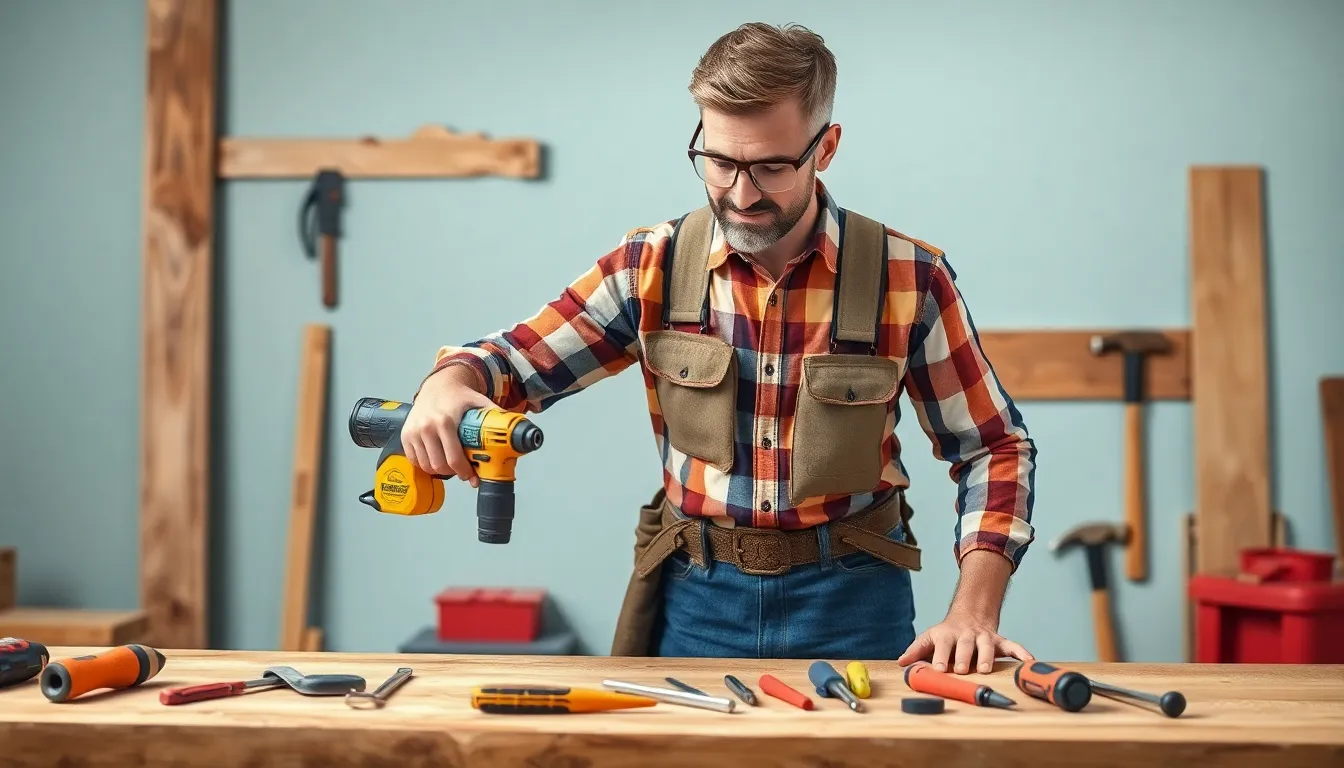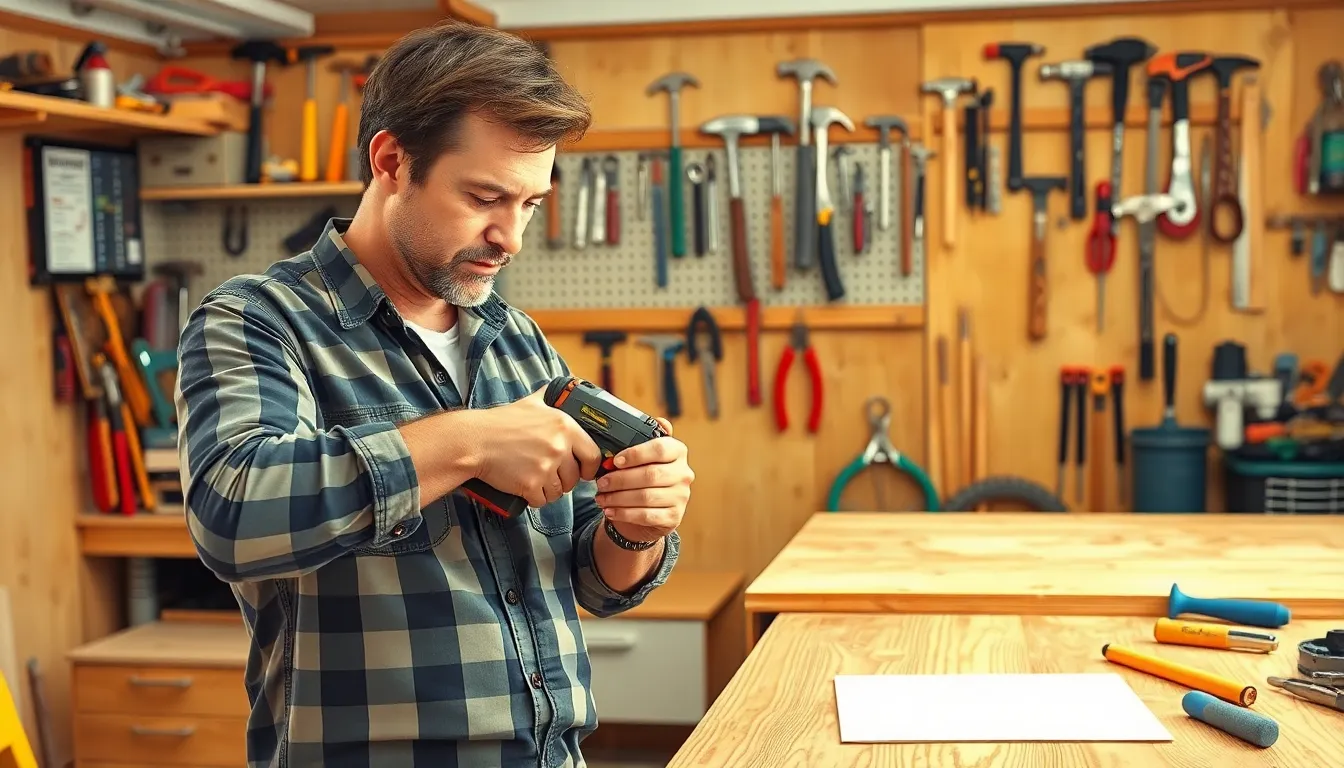Table of Contents
ToggleIn a world where DIY projects reign supreme, having the right tools can make all the difference. Whether it’s fixing that pesky leaky faucet or crafting a Pinterest-worthy bookshelf, the right DIY tool can turn a potential disaster into a masterpiece. Imagine wielding a power drill like a wizard with a magic wand—transforming mundane tasks into epic adventures.
What Is a DIY Tool?
A DIY tool refers to any instrument or device designed for do-it-yourself projects. Many people utilize these tools for home improvement, repairs, and various crafting tasks. Common types of DIY tools include hand tools, power tools, and specialty tools, each serving distinct purposes.
Hand tools encompass items like hammers, screwdrivers, and wrenches, which require manual effort. Power tools, such as drills, saws, and sanders, automate certain tasks, saving time and energy. Specialty tools address specific needs, including tile cutters or plumbing snakes, making particular tasks more manageable.
Professionals and hobbyists alike rely on DIY tools for their versatility and efficiency. An individual can achieve precise results with the right tool at hand. High-quality equipment not only enhances performance but also ensures safety during projects. Experts often recommend standard brands known for durability and reliability.
DIY tools can range from basic to advanced, depending on the complexity of the project. For instance, a novice may start with a simple toolbox containing essentials, while an experienced DIYer may invest in an entire workshop filled with advanced equipment. Choosing suitable tools aligns with project goals and personal skill levels, fostering a sense of accomplishment.
DIY tools play an essential role in transforming ideas from vision into reality. Whether for minor repairs or intricate crafts, having the right tools available makes a significant difference.
Types of DIY Tools

Understanding the types of DIY tools enhances project outcomes. Each tool category serves distinct functions and purposes.
Hand Tools
Hand tools include instruments essential for manual tasks. Hammers, screwdrivers, wrenches, and pliers comprise basic hand tools every DIYer needs. These tools don’t require electricity, making them reliable for simple repairs and craft projects. Small and portable, hand tools can fit into various spaces and offer precise control. For intricate tasks, they provide a sense of familiarity and tactile feedback. Maintenance involves regular cleaning and occasional sharpening, ensuring longevity and performance. High-quality hand tools contribute to efficiency and safety during use.
Power Tools
Power tools elevate DIY projects with automated capabilities. Drills, saws, sanders, and grinders represent common power tools in any workshop. They save significant time and effort, particularly for larger tasks. Battery-operated options further enhance portability, allowing use in various locations. While more complex than hand tools, understanding their operations is straightforward. Safety features, like guards and automatic shut-off, minimize risks during operation. Investing in quality power tools ensures durability and reliability for ongoing projects. Versatile attachments expand their functionality, making them invaluable for experienced and novice DIYers alike.
Essential DIY Tools for Beginners
Beginners benefit greatly from having essential tools that streamline their DIY projects. The right tools make tasks easier and enhance the overall experience.
Must-Have Hand Tools
Every DIY enthusiast needs a set of reliable hand tools. Start with a claw hammer, perfect for driving nails and removing them easily. A set of screwdrivers, including both flat and Phillips head options, offers versatility for various fasteners. Pliers come in handy for gripping and twisting wires or screws. Additionally, a tape measure provides accuracy for precise cuts and measurements. Include a utility knife for cutting materials like cardboard or thin wood. Finally, a level ensures that projects are straight and even. These hand tools equip beginners for countless tasks.
Must-Have Power Tools
Power tools simplify larger and more complex projects. An electric drill serves as a fundamental tool, allowing for quick drilling and driving of screws. A circular saw makes cutting wood swift and accurate, ideal for furniture building or home repairs. Consider a jigsaw for intricate cuts in various materials. A sander smoothens surfaces efficiently, enhancing the finish of woodworking projects. Adding a cordless impact driver boosts convenience with its powerful performance and portability. Lastly, a rotary tool proves useful for detailed work, such as sanding or engraving. Investing in these power tools increases productivity and results.
Tips for Choosing the Right DIY Tool
Choosing the right DIY tool ensures project efficiency and success. Practical considerations make a significant difference in achieving desired results.
Assessing Your Project Needs
Identify specific tasks before selecting tools. Understanding project requirements determines whether hand tools or power tools are necessary. For example, complex renovations may require power tools like saws and drills, while simple repairs could only need hand tools such as screwdrivers and hammers. Evaluating one’s skill level also plays a crucial role in tool selection. Selecting tools appropriate for personal experience boosts confidence and enhances project outcomes. Consider the size and scope of projects, as specific tools cater to unique tasks.
Budget Considerations
Establishing a budget leads to informed tool choices. High-quality tools often represent a greater upfront investment but provide superior durability and efficiency over time. Setting a clear financial plan helps prioritize necessary tools over extravagant options. Researching various brands and comparing features helps uncover affordable yet effective choices. Discounts and sales events can offer opportunities to obtain quality tools without overspending. Planning for future projects allows for a more comprehensive budget, preventing the need for impulse purchases. Always factor in potential maintenance costs when assessing overall expenses.
Maintenance and Care for DIY Tools
Maintaining and caring for DIY tools is essential for longevity and performance. Regular cleaning prevents rust and build-up, ensuring tools remain in optimal condition. After each use, wiping down surfaces with a damp cloth eliminates dust and debris. For power tools, following the manufacturer’s guidelines for cleaning and care enhances their lifespan.
Lubricating moving parts reduces friction, extending the life of tools like drills and saws. Applying a few drops of oil periodically keeps mechanisms functioning smoothly. Inspecting tools regularly for wear or damage allows for early repairs, which can prevent further issues. It’s important to replace worn or damaged parts, ensuring safety during use.
Storing tools properly contributes to their longevity. Keeping hand tools in a dry environment prevents moisture accumulation and rust. Organizing tools in a toolbox or pegboard enhances accessibility, making it easier to find what is needed for projects. For power tools, utilizing cases or storage racks protects them from damage.
Sharpening blades and bits maintains cutting efficiency. Investing in a quality sharpening kit or using a professional service can improve performance. Additionally, adhering to safety protocols while using tools reduces the risk of accidents. Wearing appropriate personal protective equipment ensures a safe working environment.
Finally, keeping a maintenance log for each tool helps track usage and care routines. Documenting maintenance activities assists in identifying patterns that require attention. Following these maintenance practices optimizes the performance of DIY tools, leading to successful and enjoyable projects.
Equipping oneself with the right DIY tools is crucial for achieving successful outcomes in various projects. Whether tackling simple repairs or embarking on creative endeavors having quality hand and power tools can make all the difference.
Prioritizing tool maintenance and understanding individual project needs ensures efficiency and safety. By investing time in selecting suitable tools and caring for them properly DIY enthusiasts can transform their visions into reality with confidence.
Ultimately the right tools not only enhance performance but also make the journey of DIY projects more enjoyable and rewarding.





